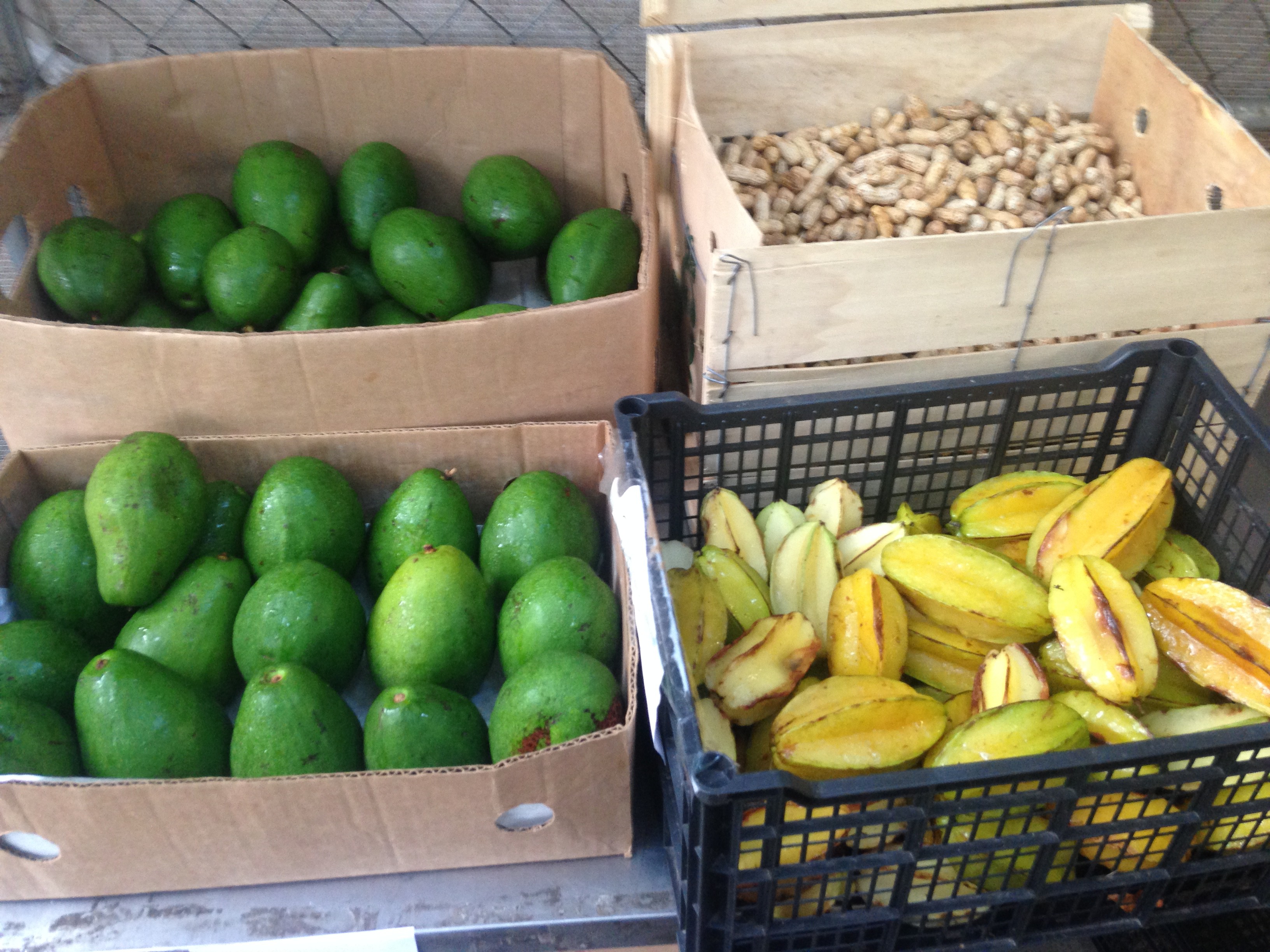
by Heidi Copeland | Aug 24, 2015
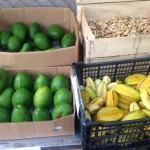 Local, seasonal food has been the subject of federal, state, and local government policy in recent years as consumer interest in and demand for this kind of food has grown. In fact, research from the UF/IFAS Center for Public Issues Education (piecenter.com/local) shows Floridians spent $8.3 billion on local food in 2012. Not only is this dollar amount continuing to grow, consumers are continuing to look for more local food options. In fact, they are interested in most anything offered and flexible about what they purchase!
Local, seasonal food has been the subject of federal, state, and local government policy in recent years as consumer interest in and demand for this kind of food has grown. In fact, research from the UF/IFAS Center for Public Issues Education (piecenter.com/local) shows Floridians spent $8.3 billion on local food in 2012. Not only is this dollar amount continuing to grow, consumers are continuing to look for more local food options. In fact, they are interested in most anything offered and flexible about what they purchase!
Still, there is no consensus about how to define “local food systems.” Is it local because of geographic distance? Or is it local because it is grown within the state? Are there exceptions when the products you want are available or are out of season? Whatever your standard definition for local food, consumers are eating it up!
Retail grocery stores, farmers markets, Community Supported Agriculture (CSAs), roadside stands, U-pick operations, and restaurants were among the most popular places the aforementioned research found consumers purchasing their local food. Additionally, consumers want this food easy to access, high in quality and not too high-priced.
Both the United States Department of Agriculture (USDA) and the Florida Department of Agriculture and Consumer Services (FDACS) support this growing movement. USDA’s National Farmers Market Directory provides consumers with convenient access to information about farmers market listings to include: market locations, directions, operating times, product offerings, accepted forms of payment, and more. (http://search.ams.usda.gov/farmersmarkets)
FDACS maintains a list of community farmers markets throughout Florida, but, because community farmers markets are not required to register with the Department, the list is not a complete one. Being listed does not imply that a market is endorsed, approved, or otherwise sanctioned by FDACS. (http://www.freshfromflorida.com/Divisions-Offices/Marketing-and-Development/Consumer-Resources/Buy-Fresh-From-Florida/Community-Farmers-Markets)
According to FDACS, Fresh From Florida produce available during the month of August includes: avocado, carambola, guava, longan, lychee, mango, mushroom, passion fruit, and peanuts.
So many opportunities exist for folks to eat healthy and seasonally. Are you getting your share? Stop by your favorite source and stock up on what’s Florida-fresh this month!
http://www.freshfromflorida.com/Divisions-Offices/Marketing-and-Development/Consumer-Resources/Buy-Fresh-From-Florida/Crops-in-Season
by Heidi Copeland | Jul 22, 2015
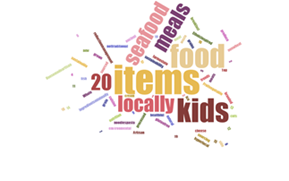
Food Trends word cloud
Upon hearing the word “trend”, you may think fashion. Fact is, foods trend too! Last October, nearly 1,300 members of the American Culinary Federation were given a list of 231 items and asked to rate each item as a hot trend, yesterday’s news or a perennial 2015 favorite. I dare say, many of these leanings, just a couple of years ago, might have been considered a bit unusual. But food trending is neither unusual nor a mere passing. And thanks to those folks embracing the unusual, much of what is now trending becomes the new normal.
I think you will agree that these top 20 food trends are a movement in the right direction:
- Locally sourced meat and seafood
Many consumers are becoming more interested in knowing where their food is coming from.
- Locally grown produce
The definition of locally grown food is not something that is regulated. Local can mean the food comes from around the corner or across the state. Know your farmer, know your food.
- Environmental sustainability
In an ideal farm system, agriculture works in harmony with nature. The idea is that as farmers take from the land, they also give back.
- Healthful kids’ meals
As children grow, help them choose healthy meals and snacks. Eating right helps provide the nutrients needed to be healthy. Teach good eating habits.
- Natural ingredient/minimally processed food
Consumers are demanding “real” foods – fresh, seasonal and less processed. Plus, consumers are seeking to have an impact on improving the environment. This is fueling a demand for what consumers consider to be real food. In fact, major restaurant chains are claiming they too will quit using additives – of any kind. Can you imagine?
- New cuts of meat
Eat a whole animal, leaving nothing but the squeal has made less popular cuts of meat trendy again. An added benefit is that meat processing ranks as one of the most efficient in the food chain – a lot of what is not eaten gets rendered. The animal is broken down into non-edibles that end up in dozens of other products — some of which may surprise you.
- Hyper-local sourcing
In respond to consumer demand for fresher more sustainable foods, some restaurants have begun using ‘hyper-local sourcing’. A good example of hyper-local sourcing would be an on-site or local garden to supplement their kitchens.
- Sustainable seafood
Food & Water Watch has analyzed many different fish and shellfish to create a guide that assess human health and environmental impacts of eating certain seafood, as well as the socio-economic impacts on coastal and fishing communities. http://documents.foodandwaterwatch.org/doc/Seafood_Guide_2013.pdf
- Food waste reduction
Can you believe a few cities in the US make it mandatory for its residents to compost food waste! Demands are much easier to digest knowing that each of us is VERY wasteful…… experts surmise that up to 30% of food produced is thrown away! How can this be helped? Learn to cook. Get organized. Be resourceful! As an example, you can turn yesterday’s leftover vegetables into tomorrow’s breakfast frittata!
- Farm/estate branded items
Although this is just another marketing tool, who doesn’t like something that sounds like it came from a quaint little neighbor’s farm?
- Non-wheat noodles/pasta
Along with the growing popularity of gluten free eating there is growing popularity to consume noodles made from things other than wheat. Have you tried rice, quinoa, mung beans, kelp, sweet potato or zucchini pasta? Many of these non-wheat alternatives are quite tasty and can be made yourself.
Have you seen the spiral cutters or julienne peelers?
- Gluten free cuisine
As stated earlier, one unifying theme for 2015 is grain variety. Many grains do not contain gluten, the protein composite found in wheat and related grains. With a bit of adjustment, gluten free grains can be made into many of the products to which we’ve grown accustom to eating.
- Ancient grains
You know whole grains have gone mainstream when you can purchase everything from chips to smoothies made from whole grains – and I’m not talking wheat, rice and oats. Buckwheat, barley, brown rice flour, quinoa, chia, sorghum and amaranth, flax, and spelt, are all beginning to seem pretty normal.
- Whole grain items in kids meals
Good nutrition can taste good too! Whole grains have also become the norm in school meals.
- Non-traditional fish
As mentioned in number 8, fish is trending. Nutrition Action newsletter has an excellent article worth reading. SOS: Save our Seafood, What’s good for us and the oceans. It was written by Barton Seaver, the director of the Healthy and Sustainable Food Program at the Harvard School of Public Health. http://cspinet.org/new/pdf/cover_story_-_save_our_seafood.pdf
- Ethnic-inspired breakfast items
Meats, fish, cheeses, breads, rice, fruit, vegetables, eggs…..even beans can go here!
- Nutrition
You can learn a lot from a label. Learn how to read one. http://www.fda.gov/Food/IngredientsPackagingLabeling/LabelingNutrition/ucm274593.htm
- House-made/artisan ice cream
In keeping with the whole “food conscientious” theme, even ice cream lovers are opting for fresh, seasonal ingredients. Ice cream is definitely a summer favorite and is best when it’s fresh and homemade!
- Fruit/vegetable kids side items
Fruit and veggies are now available in snack packs! Apparently, even some vending machines are selling baby carrot packs. Not to mention all the frozen smoothie products that contains both fruits and vegetables – without sugar.
- Artisan cheeses
This is a growing niche market and delicious at that! Artisanal cheese refers to cheeses produced by hand using the traditional craftsmanship of skilled cheese makers. Many artisan cheeses can also be called farmstead cheeses, as they are made with milk from the producer’s own herds of cows, sheep, and goats.
The next time you shop for food, give a nod to those early adopters who are embracing the unfamiliar. A considerable amount of the new foods we are seeing and eating today are better for us and better for the environment. This movement is here to stay.
Please click here to answer a few questions to help us better serve you.
by Heidi Copeland | Jul 15, 2015

July is National Ice Cream Month
July: National Ice Cream Month
Why not start this month off with a treat! In 1984, President Ronald Reagan declared July as National Ice Cream Month and the third Sunday in July (July 19th) as National Ice Cream Day! Actually, the whole month of July is supposed to be celebrated with “appropriate ceremonies and activities.” Ice cream is both nutritious and delicious…… eaten in moderation of course, but it can also be confusing. Not all frozen treats are in fact ice cream!
What really is ice cream? Real ice cream or ice-cream is a frozen dessert made from dairy products, such as milk and cream, combined with flavorings and sweeteners, such as sugar. American federal labeling standards require ice cream to contain a minimum of 10% milk fat per 1/2 cup serving and 20% total milk solids by weight. This mixture is stirred slowly while chilling to prevent large ice crystals from forming. A term used in making commercial ice cream is overrun. Overrun means the liquid mixture, once completely chilled can have expanded up to double its original volume by the incorporation of air. This results in a smoothly textured ice cream free from palpable ice crystals or sandiness.
Overrun helps explain the vast price discrepancy between ice cream brands. More expensive brands normally use more and better quality ingredients and have less overrun whereas as less expensive ice cream brands tend to use the minimum amounts of ingredients required by law and more air. Thus, the weight of a half-gallon can indicate quality too.
There are many variations to the basic ice cream recipe. Reading the label of a favorite product helps the consumer learn what is in their favorite brand.
When egg yolk solids are added to ice cream the name has to reflect this. “Frozen custard” or “French ice cream” or “French custard ice cream” is ice cream with the added egg yolk.
Super premium ice cream tends to have higher than standard ice cream recipe. High fat contents and more expensive, best quality ingredients add calories and expense.
Ice milk is not a type of ice cream you see much anymore: it has been replaced by reduced fat products. Years ago ice milk was the low fat version of ice cream. Ice milk is not required to contain the standard minimum of milk fat. However, reduced fat ice cream is required by law to have 25% less fat than that particular company’s regular version. Nonetheless, calories lost here by reducing the milk fat might be made up by other added ingredients such as candy bits. Even light versions of the premium brands can have more fat and calories than plain ice cream. Again, you learn a lot from a label.
Frozen yogurts, made from yogurt, are a dairy product, with the addition various sugars and flavorings. However, yogurt’s reputation for healthfulness is not always accurate and unlike ice cream there are no Federal standards of any kind for frozen yogurt
Gelato is a type of soft ice cream containing a relatively small amount of air. This makes the product dense, rich and creamy. Gelato can be made with milk, cream, various sugars, and flavoring such as fresh fruit. Gelato is generally lower in calories, fat and sugar than ice cream. In the United States there is no standard of definition for gelato set forth by the United States Food and Drug Administration.
Are sorbet, sherbet, and sherbert all the same? Despite the fact that the legal definitions of sorbet and sherbet could be used interchangeably, there is a distinction among American frozen dessert manufacturers. Sherbet — which is alternatively spelled sherbert — is a frozen fruit and dairy product that contains anywhere from 1 percent to 3 percent milk fat from milk or cream. On the other hand, sorbet generally implies a fruit-based frozen dessert with little to no dairy — although the use of the term sorbet is unregulated industry standards want them free from surface crustation, brittleness, syrup bleeding, and large ice crystals.
Confused yet? New to the frozen dessert market are novelty frozen concoctions made with nondairy to mimic ice cream. Welcome, delicious dairy free, soy milk, coconut milk and almond milk frozen desserts. Notice, these products are not called ice-cream but are so smooth and creamy you might not even realize.
In 1984, when President Ronald Regan’s crafted the unique proclamation to eat ice cream folks didn’t have so much to choose from. You do. Enjoy a frozen treat but know what you are buying…….. You can learn a lot from a label.
http://www.icecream.com/icecreaminfo
[Code of Federal Regulations] [Title 21, Volume 2] [Revised as of April 1, 2014] [CITE: 21CFR135.110]
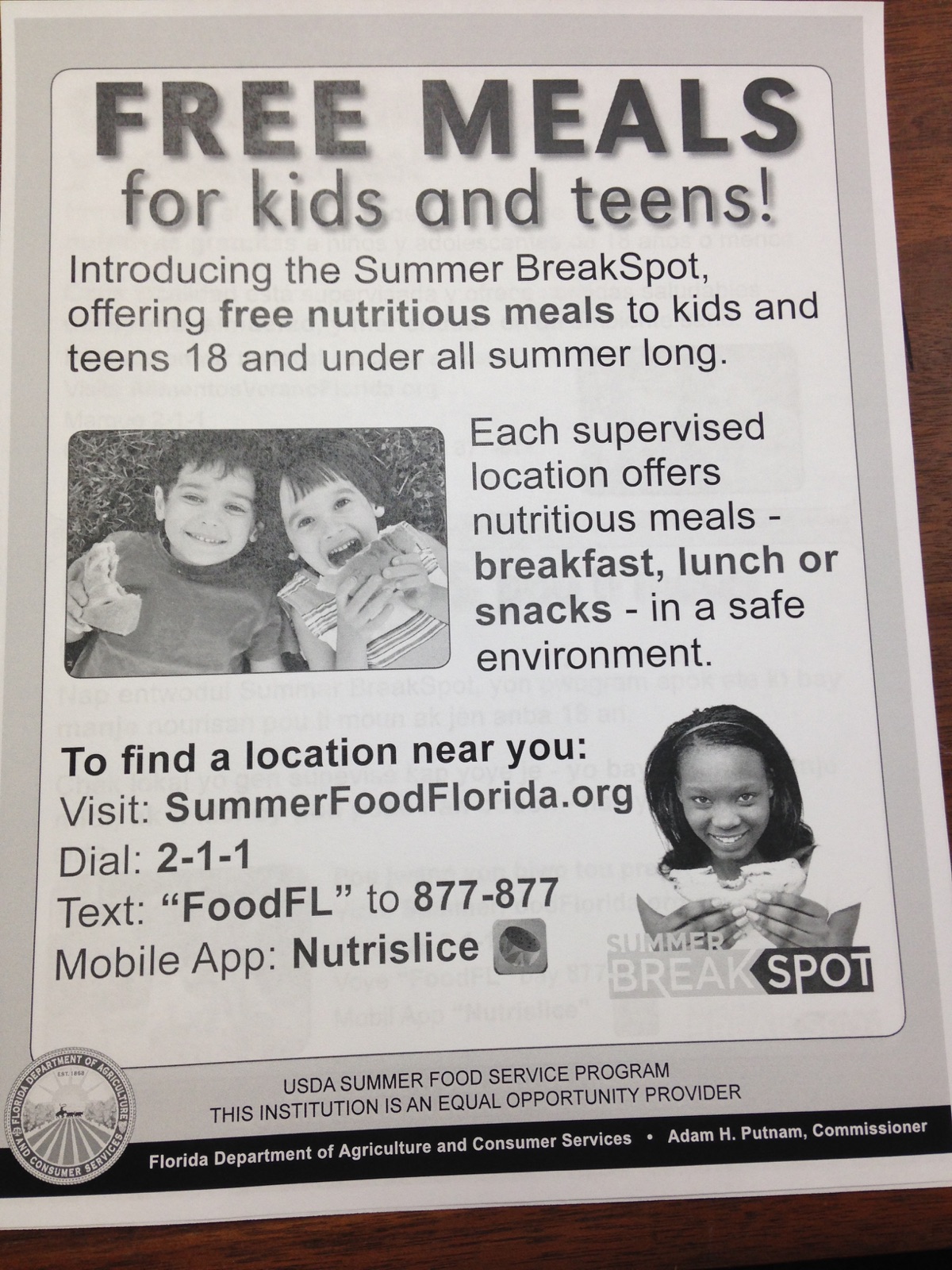
by Heidi Copeland | Jun 26, 2015
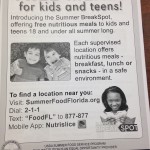
Summer Break Spot
With school out for the summer, many children may miss out on a meal they normally would receive through USDA’s school meals programs. Florida’s at-risk children now can have meals all summer long.
The Summer Break Spot Program, also known as the Summer Food Service Program, is federally funded under the U.S. Department of Agriculture (USDA) and, in Florida, administered by the Florida Department of Agriculture and Consumer Services. Summer Break Spot sites are locally operated by nonprofit organizations such as schools, community centers, recreation centers, and faith-based organizations.
There is no cost for these nutritionally balanced meals that meet USDA guidelines – breakfast, lunch and snack. However, the site may have a fee set for the activity program they provide. Plus, there is no application necessary and any child 18 or younger can simply show up during meal times to receive a meal.
Currently, Tallahassee has twenty listed Summer Break Spot sites. Sites will be added continually throughout the summer. Find a feeding site in your area using the interactive website. (http://www.summerfoodflorida.org/Find-a-Site or Dial: 2-1-1, Text:”FoodFL” to 877-877, Mobile App: Nutritslice
Have other questions? Contact the Program Director by email at Rachel.Mohler@FreshFromFlorida.com or by calling 1-800-504-6609.
If there are no feeding sites in your community, you can mobilize your community to sponsor the program. Contact the Program Director to learn how.
Let’s help insure that kids in our community don’t go hungry this summer.

by Heidi Copeland | Jun 5, 2015
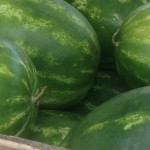 Rarely do I hear the phrase “school’s out” and not think of my own summers of fun and, of course, Alice Cooper’s 1972 major hit single “School’s Out for Summer” – does that age me?
Rarely do I hear the phrase “school’s out” and not think of my own summers of fun and, of course, Alice Cooper’s 1972 major hit single “School’s Out for Summer” – does that age me?
In fact, “word” has it that Alice Cooper said he was inspired to write the song when answering the question, “What are the greatest three minutes of your life?” Cooper said: “There are two times …The second one being “the last three minutes of the last day of school!”
Summer break is here and that may mean time for a big change to your daily routine. Even though summertime is fun, there still can be challenges for families who have to juggle and adjust!
The key is to plan ahead. Being prepared helps you enjoy the long days of summer. This is especially true when it comes to summer food. Kids associate summer with FUN. Much more fun can be had if you don’t have to spend time in the kitchen – cooking! (But that, too, can be enjoyable!)
Summer is an amazing time! There is an abundance of fresh, delicious, and healthy choices bursting with health benefits. Best yet, many of these foods do not even have to be cooked! With a general washing and perhaps a bit of slicing and dicing, many summer foods can be eaten without further preparation.
One of my favorites is watermelon! It’s like drinking your water and eating it, too! Watermelon helps keep you hydrated (watermelon is 92 percent water). Plus, one cup of diced watermelon contains 43 calories, 0 grams of fat, 2 grams of sodium, 11 grams of carbohydrate, and 1 gram of fiber. One cup of watermelon will provide 17% of vitamin A, 21% of vitamin C, 2% of iron, and 1% of calcium needs for the day. Watermelon also contains thiamin, riboflavin, niacin, vitamin B-6, folate, pantothenic acid, magnesium, phosphorus, potassium, zinc, copper, manganese, selenium, choline, lycopene, and betaine. And, according to the National Watermelon Promotion Board, watermelon contains more skin- protecting lycopene than any other fruit or vegetable (lycopene also gives watermelon its bright pink color). Research shows that eating foods that are full of water helps keep you satisfied on fewer calories.
Watermelon actually is considered a nutrient-dense food – it provides a high amount of vitamins, minerals, and antioxidants for a low number of calories.
But don’t stop at watermelon. The Florida Department of Agriculture and Consumer Services has a fantastic website promoting buying “Fresh From Florida.” In fact, their website devotes an entire section to “Fresh from Florida Foods.” This month, June, we have quite a bounty to be thankful for. Not only are the foods on this list nutritious, they are delicious and, for the most part, many require little preparation to be consumed (plus, food in season generally is less expensive and tastes better).
Print yourself a copy of What’s in Season Now and go have some summer fun!
Just in case you don’t have time to print the list, here is what is in season now….avocado, cantaloupe, eggplant, guava, lychee, mango, mushroom, orange, papaya, passion fruit, peanut, potato, sweet corn, tomato, and watermelon. Look for these foods at local farmers’ markets or in your supermarket’s produce section.
Enjoy the tastes of summer from the Sunshine State!

 Local, seasonal food has been the subject of federal, state, and local government policy in recent years as consumer interest in and demand for this kind of food has grown. In fact, research from the UF/IFAS Center for Public Issues Education (piecenter.com/local) shows Floridians spent $8.3 billion on local food in 2012. Not only is this dollar amount continuing to grow, consumers are continuing to look for more local food options. In fact, they are interested in most anything offered and flexible about what they purchase!
Local, seasonal food has been the subject of federal, state, and local government policy in recent years as consumer interest in and demand for this kind of food has grown. In fact, research from the UF/IFAS Center for Public Issues Education (piecenter.com/local) shows Floridians spent $8.3 billion on local food in 2012. Not only is this dollar amount continuing to grow, consumers are continuing to look for more local food options. In fact, they are interested in most anything offered and flexible about what they purchase!





